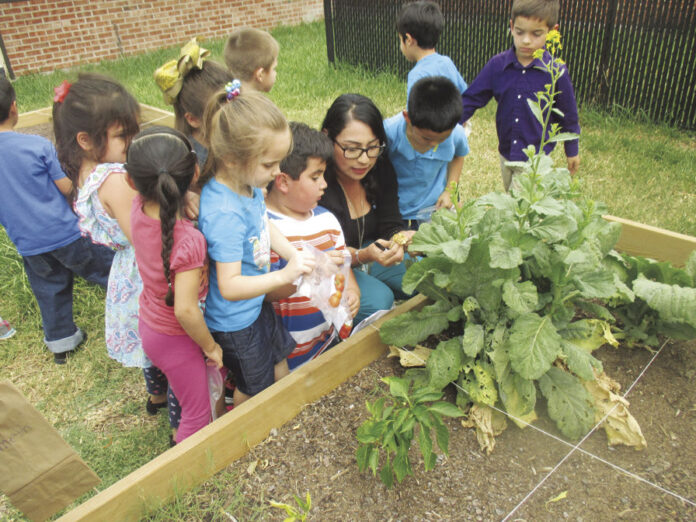HARLINGEN — The scores are in, and the school district is delighted.
“Our science scores, district wide we scored a 96,” said Mary Alvarez, early childhood specialist for the Harlingen school district.
Alvarez and other school district administrators are celebrating the success of this year’s pre-kindergarten students. They’ve performed extremely well in not only literacy but also math and science.
Last year’s science scores were in the 70s, Alvarez said.
She attributed the improvement to the use of new resources. STEMscopes Early Explorer, developed by Rice University, uses 12 modules to teach science, math and technology. It uses centers in different parts of the classroom to teach different subjects to pre-kindergarten students.
“We are STEM heavy,” Alvarez said. STEM stands for Science, Technology, Engineering and Math.
“We bought iPads for all of our pre-K classrooms, a set of six for each one,” she said. “Over half our teachers are certified as Apple Teacher Educators and the other half will probably have their certification this summer. The pre-K teachers will be Apple certified teachers.”
Apple Teacher Educator is a certification from Apple which insures instructors know how to use the company’s online resources. The district has received a number of grants and resources from Apple.
The district was able to purchase the iPads through a $585,000 High-Quality Prekindergarten Grant from the Texas Education Agency. The iPads and other technological devices are being used in a variety of classroom activities. The technology, along with new innovative furniture, is being used to accommodate new approaches to learning.
“What the high quality pre-K grant allowed us to do was to pay for teacher training, which we did,” she said. “Then we bought curriculum pieces to enhance what we already have. We added the STEM scopes, we added the Neuhaus, we added the iPads.”
Literacy scores also increased substantially due in part to the use of the new phonics program from Neuhaus Education Center called Accurate and Automatic Decoding. The program uses phonics to teach children how sounds form words.
“Phonics is about making that letter/sound connection, like when you see that letter, you know what sound it makes,” Alvarez said.
Early Explorers combines classroom learning with hands-on experiences outside.
“In the science domains, we do physical science and we also do life science,” Alvarez said. “The lessons describe which animals need shelter; they describe the life cycle of certain organisms. We also do earth and space science skills.”
Children also learn such concepts as sink and float, heat and cold, and measurements.
“They observe of course the sky, objects in the sky,” Alvarez said. “They discuss and learn the things that happen in the earth and sky, the sun, the phases of the moon. They learn the importance of caring for the environment and our planet as well.”
Throughout the district, pre-kindergarten teachers have reported exceptional progress with the children. The world inside begins now to serve as a springboard to the larger one outside, where young minds search for animals and the food that keeps the cycle of life turning.
Children going beyond classroom learning
HARLINGEN — Energy.
It’s everywhere, in the wind, the water, the sun and rain. It’s in the power of a waterfall, the electricity racing through power lines, and the endless messages running through the Internet.
It’s in the powerhouse of the human brain, where curiosities of the Harlingen school district’s pre-kindergartners are discovering the wonders of power in the form of food.
“Samuel, awesome job!” said Cynthia Gonzalez, a pre-kindergarten teacher at Jefferson Elementary.
Samuel Gomez had showed her a plastic bag with a picture of a butterfly in one hand, and in the other he held up a small flower he’d picked.
His mission had been to seek the food which powers butterflies. This had been the task of all the children in both Gonzalez’s class and that of Blanca Estrada’s Spanish speakers.
As part of the district’s STEMscopes Early Explorer program, the children were learning how animals — birds, deer, raccoons, butterflies, dragonflies — all need power. They get it from the different foods they eat. Just like people.
They’d filled the playground with pictures of butterflies, worms, birds and other creatures.
Samuel held up the tiny bloom.
“What does the butterfly take from the flower?” Gonzalez asked.
Samuel hesitated. He’d reached the first step, and Gonzalez was leading him toward the next.
“I want to help,” said Idelsy Avalos.
Gonzalez nodded to her and the youngster said, “Nectar.”
Encouraged by the “right answer” the children more eagerly sought to determine what their animals ate. One boy held up a picture of worms for Gonzalez to see.
“What do worms eat?” Gonzalez asked, giving him a sort of prompt.
“Corn,” he said uncertainly.
Gonzalez nodded and added, “They like things that are rotten and decaying.”
The boys suddenly seemed to hit upon the idea and said, “Apples.”
“Yes, decaying apples,” Gonzalez said excitedly.
They headed farther into the playground toward a garden they’d planted. The children quickly fetched tiny tomatoes and showed where animals had fed on them. A large clump of churd revealed all sorts of surprises.
“Gosh you have ants,” Gonzalez said. “There’s a lot of ants.”




